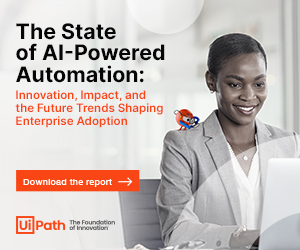
Appian has been thinking about workflows and automation for much of its 21-year history – far longer than robotic process automation has been in existence. But, its commitment to providing “low-code” software via the cloud that enables an organization to enhance its human capital prompted the company to add RPA to its core product offering.
In March 2020, Appian announced Appian RPA, the result of the company’s acquisition of Spanish technology firm Novayre Solutions and its Jidoka RPA platform earlier in the year.
Chief Technology Officer and co-founder Michael Beckley sat down with RPA Today’s Steve Casco to talk about history, AI, analytics, process, the cloud and how RPA fits into automation.
RPA Today: The notion of automating business processes using software is a fairly recent innovation. Can you describe how Appian has evolved over two decades into an automation company?
Michael Beckley: One of my co-founders and I came from an analytics company. When we started Appian that’s what we were, but it wasn’t what we wanted to be. Rather than just studying things, from the start we wanted to build a framework that allowed businesspeople to take control of their world. We did analytics work to fund software development. And, the majority of the companies that needed analytics work in 1999 and 2000 were telcos.
But the telcos crashed in 2001. Now there was no easy money in analytics consulting. We had to become a software company right away.
By the good fortune of being located in Washington, D.C., I got to know CIOs in the federal government and other vendors in the federal marketplace. That made it fairly easy to diagnose what the government was going to spend a fortune on in 2001. And, that was web portals. Our first product was a portal for the federal government.
After a few years, we had experience building industrial-strength, secure software at scale. But, our focus was on enabling business people not just to access information but to build new information systems, build new business processes. We immediately settled on visual workflow-building technology and this crazy notion that you should be able to build an application through a web browser.
The idea came from our customers. They had millions of users distributed worldwide but they did not want to install our software on a million client machines. It was too expensive. It had to be a browser. That’s how, in the early 2000s, we learned to build cloud software at scale. We also settled on building a low-code framework, which in those days was called business process management.
RPA Today: Your early evolution into the cloud showed you were innovative, but what brought automation to the forefront of your efforts and how do you define automation?
Michael Beckley: We focused on human workflow and the analytics around the human workflow to optimize it. From day one, our experience in analytics suggested that, ultimately, businesses were going to be delegating tasks not to humans but to scripts, to algorithms and to AI. But, the technology at the time simply wasn’t good enough.
The AI algorithms they were using, mainly in e-commerce, were terrible. We worked with them and realized we needed to make it easier for AI. Having a visual model of an end-to-end process is the basis for automation technologies. You’re providing common sense, the context. You give AI the goal, you give AI the data that’s clean and structured into a human workflow, you validate the data coming in with business rules and that’s how you lower the barrier to entry for automation.
Automation is just workflow with new workers. Those new workers are enhancing human potential with AI algorithms and RPA bots. That’s it.
RPA Today: When you realized RPA had to be part of any automation platform, what went into the build/buy decision?
Michael Beckley: We built robotic workforce management features into our product for years, so we were well versed in what was missing from RPA. It was missing a cloud orchestrator, management of state for the bots, ROI analysis, independent verification of the bot work, the ability to automatically escalate to humans and maintain SOAs, the ability to have a good rigorous process for what tasks to automate. We were able to provide that with RPA partners.
But RPA got so much hype and buzz that customers would rush straight to an RPA vendor and think they were going to solve all their problems. We realized we had to get into the conversation earlier, we had to have our own native RPA capability.
We started down the build path like we always do. Appian has gone 21 years with completely organic growth. And, given our corporate culture, any RPA product we offered was always going to be cloud. The idea of building an attended bot that had to live on your desktop was anathema. It was against our fundamental design philosophy.
But then we came across a smaller company that had built cloud RPA from day one and had done it in Java. They had great people who were laser-focused on building great technology, but they didn’t have the marketing we did. What they also didn’t have was the low-code.
We’ve come close a few times to buying companies, but this was the first time the value prop was so obvious and so urgent and so consistently compatible with our vision and technology.
RPA Today: You mention “low-code.” What is it and what does it mean in relation to RPA?
Michael Beckley: Low-code is a model-driven approach to building and changing applications and workflows. Low-code is a component-based approach to both your interface components and your underlying business logic as well as your data on the back end. Low-code is a way to put IT and business on a shared view of your applications.
We’re not just talking about any one thing in an enterprise. You need to have a way for IT to build an environment in which enterprise data of all kinds from many different systems and clouds is accessible. You need business processes that empower line-of-business leaders to own their own workflows and business rules. With guardrails, they need to be able to rapidly change what they can and get rapid response from IT when new data, new processes and even new applications are required.
This a new way to build mission systems rather than getting software off the shelf or doing custom coding. You can use model driven architecture and pre-existing components to rapidly assemble new workflows, new automations and new applications.
RPA Today: Let’s talk about current events. RPA has opportunities during a crisis like we are facing in the Covid-19 pandemic. But it ran into problems as well. What is the right way to leverage RPA in exceptional circumstances?
Michael Beckley: What we’re facing now is a perfect example of why RPA on its own can’t replace humans. It should always augment human potential. RPA is terrific at bridging that last-mile gap to legacy systems or integrating into an app that doesn’t have an API. Yet, when you rely on it solely, you create rigidity and an inability to take advantage of humans’ best potential, which is to be agile and respond to changing information and changing circumstances.
So Covid comes along. Congress passes the PPP on a Thursday and by Friday banks have to be making loans to small businesses. Our customers were able to build APIs and rapidly assemble applications to start handling these loans. Many used RPA to pull data from existing internal systems.
Some banks, however, were using RPA to submit loan applications directly from the business customer to the SBA. I would call that an “antipattern” – using a bot to throw a large workload of forms at a third-party website you don’t own or have permission from to do so. But they did it and the response was predictable. The SBA banned RPA submission and required banks to use an API or a human workflow.
The main lesson is, when speed and agility matter, use automation to enhance human potential. But keep humans in control.
RPA Today: Let’s look ahead. What do you see in the RPA market over the next 12-18 months?
Michael Beckley: The market is still in a hyper-growth phase. While you’d expect more consolidation – and I wouldn’t be surprised to see some – it’s such a big market. I think the excessive private equity money that’s available will create even more startups. We’ll see this churn of consolidation matched with new market entrants persist for another few years.
At the same time, no one knows how the economy is going to recover. If it’s a prolonged slowdown, that will definitely clear out a lot of the noise. The first thing to take a hit in a downturn is marketing budgets. So, customers will actually see a decrease in hype and return more to looking carefully at what people are doing that is actually working and study the failed examples. If you haven’t thought through how you’re going to orchestrate your human workforce with your digital workforce, you can make some progress right away with RPA, but you’ll run into problems quickly.
I predict the automation market will come out the other end of this with a set of companies positioned to scale, grow and meet the needs of future enterprises and the future workforce.
If you liked this article, please sign up to RPA Today! Registrants will receive our free weekly RPA newsletter updating you on the most recent developments in the Robotic Process Automation, Intelligent Automation and AI space. In addition to news updates, we will also provide feature articles (like this one) with a more in-depth examination of RPA issues for end users and their enterprises.


